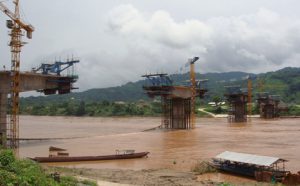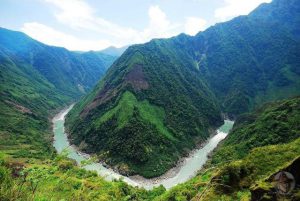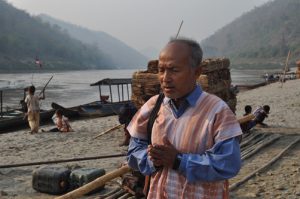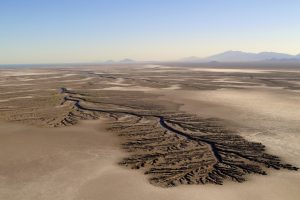Chinese plans to develop hydroelectric dam projects on transboundary rivers continue to attract controversy. Proposals to harness the power of the Lancang (upper Mekong) and Nu (upper Salween) rivers, in particular, have been framed as unilateral Chinese development schemes that ignore the concerns of downstream countries – Myanmar, Thailand, Laos, Cambodia and Vietnam – and with the potential for widespread social and ecological damage.
The completion of the 1350-megawatt Manwan Dam in 1995, the first on the mainstream of the Lancang-Mekong, paved the way for China’s largest power company, Huaneng, to pursue its plans for an eight-dam cascade on the Lancang designed to export power as far away as Guangdong.
However, the situation seemed to change in early 2004, when then-premier Wen Jiabao called a halt to a second major hydroelectric cascade on the nearby Nu River, which runs roughly parallel to the Lancang through southwest China’s Yunnan province. Environmental activists in China and overseas applauded the decision. Huadian, China’s second largest power company, had planned a series of 13 dams with a combined generating capacity of more than 21,000 megawatts for the Nu (roughly the equivalent of the Three Gorges Dam).
Wen claimed that Huadian had failed to comply with the country’s recently-implemented environmental impact assessment law, a move observers saw as a sign of the growing strength of China’s environmental regulatory apparatus. Yet preliminary work for some of the Nu dams, including site testing and construction of resettlement villages, has crept forward, and it is expected that at least four of the projects will be given official license to proceed under Xi Jinping’s administration.
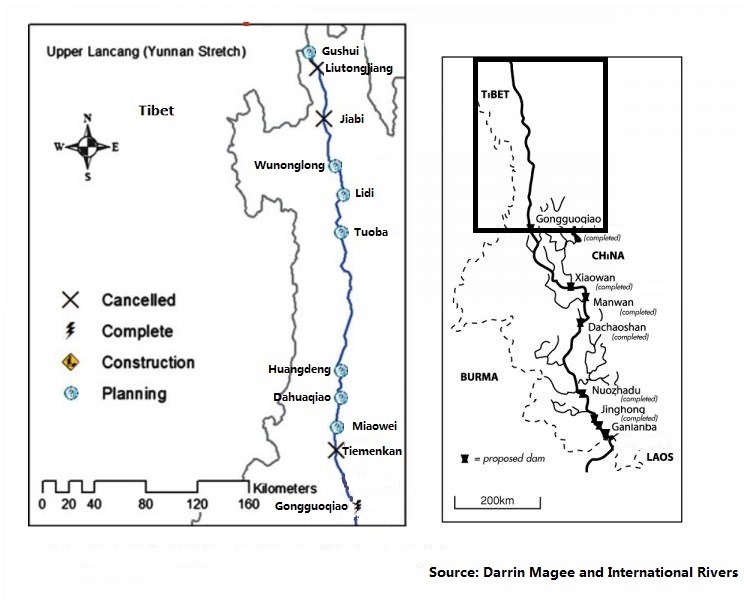
Status of hydroelectric dams on the Lancang in Yunnan (2013). Click the map to see a larger version.
At the same time, development on the Lancang has proceeded apace. Six dams of the eight originally planned for the lower and middle stretches of the river, from central Yunnan south to the Lao border, are either finished or underway.
And with the media spotlight trained on the Nu, work on a second series of Lancang dams has continued over the past decade. These dams are being built in areas where roads and power transmission infrastructure are poor, where local populations, many of whom are ethnic minorities, are often marginalised, and where local electricity demand simply does not require the quantity of power that dams of this scale will provide. Yet like those on the lower reaches of the river, they are all billed as key to rural poverty alleviation and integration of remote and relatively undeveloped areas into the industrial and urban engines in eastern China.
The upper Lancang cascade also includes a number of dams within the Tibetan Autonomous Region on the Zaqu (as the Lancang is known there), where the social and ecological uncertainties associated with a project of such scale may be even greater. Very little information is publicly available about these dams, and what information exists is unreliable.
For Chinese hydropower planners, the logic is simple: high levels of hydropower development correlate with high levels of overall economic development. Europe and the US, each with very high levels of hydropower exploitation, are seen as proof of this. China holds the world’s greatest hydropower potential, estimated at over 500 gigawatts, and a host of its top leaders have backgrounds in hydropower engineering. Unreliable or insufficient electricity has no place in a future dependent on rapid and sustained economic development, and more than half of China’s hydroelectric potential remains untapped. The case for hydropower is further strengthened by its reputation as a low-carbon energy source.
For local officials in southwest China’s Yunnan province, the logic of constructing large-scale hydropower, thousands of kilometers away from key load centres, is also clear. Yunnan is home to roughly a quarter of the country’s hydropower potential thanks to its steep mountains and voluminous rivers (at least during the rainy season). And though the power grid infrastructure across much of the southwest is relatively frail and operates at low voltages unsuitable for long-distance transfer of large quantities of electrical energy, this is changing rapidly. China Southern Grid is buying up local grids, upgrading and integrating them.
More important for the mega-scale dams operating on and envisioned for the Lancang, Nu, and Jinsha (upper Yangtze) is the development of an ultra-high-voltage direct current power lines capable of transmitting power over long distances more safely and with fewer power losses than existing lines.
Nervous neighbours
So what does Lancang hydropower development mean for China’s relations with its downstream neighbours? The area drained by the river is home to 60 million people, many of whom depend directly on the river and its associated waterways for their livelihoods. Downstream leaders and communities worry about the impacts Chinese dams might have on water availability, sediment transport, fish migration and river ecosystems.
Concerns about water availability are not unfounded in a region where summer monsoons bring torrential rains but where the dry season can see precious little precipitation. The volume of the entire cascade’s reservoirs, roughly 60 billion cubic metres, is approximately equivalent to 13% of the Mekong’s mean annual discharge. The dams with the two largest reservoirs, Xiaowan and Nuozhadu on the lower reach, occupy more than half that capacity. With Xiaowan complete and Nuozhadu expected to fill in 2017, downstream users fear China might “bank” water in large reservoirs during the rainy season for more controlled release during the dry season.
In early 2010, as the lower Mekong countries suffered under a widespread and persistent drought, many accused the Chinese of exacerbating the situation by filling the reservoir on the recently completed Xiaowan dam. Chinese officials and dam developers responded by inviting downstream officials to visit the dam site, and by promising greater transparency and data sharing, a promise as yet unfulfilled.
Concerns over sediment trapping also have some basis. Dams trap silt that would otherwise be transported downstream, retaining in their reservoirs finely ground material that would normally contribute to beaches and islands in the river and provide vital nutrients to lowlands during floods. Having lost much of its sediment in the reservoir, water exiting a dam is more likely to scour river banks, erode river habitat and potentially cause landscape instability.
Cambodia, home to the hydrologically unique and exceedingly productive (in terms of rice and fish) Tonle Sap lake-river system, has reason to suspect that some of the silt responsible for the lake’s rich soils will be trapped behind the Lancang dams. The key question, however, is how much, since Myanmar, Laos, Thailand, Vietnam, and Cambodia also contribute sediment to the river upstream of the lake system.
China’s lack of membership in the (admittedly weak) Mekong River Commission; its conviction that daily flow data on transboundary rivers are a matter of national secrecy (despite promises to increase data sharing); and its insistence on the absolute right to pursue development on waters within its sovereign territory do little to build trust and inspire confidence that Chinese dam developers or political leaders have regional interests in mind, despite occasional claims to the contrary. Unfortunately, such is the case with many of the world’s transboundary rivers.
Increasing scientific collaboration, including data sharing on issues such as the sedimentation and flow volumes would go a long way towards building trust, reducing uncertainty, and establishing the basis for cooperative management of the Lancang-Mekong, one of the world’s most important river systems. Such collaboration could then serve as a model for other rivers in the region such as the Nu and Brahmaputra.
